P O Box 20264
Waco, Texas
76702-0264
Phone:
(254) 715-8423
Fax:
(254) 759-1083
Member Texas Structural Pest Control Board
Professional Insect and Pest Control
Termites • Roaches • Ants • Small Rodents
License #TPCL11347
Subterranean Termites
Subterranean termites are the most destructive insect pests of wood in the United States. They cause more than $2 billion in damage each year, more property damage than that caused by fire and windstorm combined.
In nature, subterranean termites are beneficial. They break down many dead trees and other wood materials that would otherwise accumulate. The biomass of this breakdown process is recycled to the soil as humus.
Problems occur when termites attack the wooden elements of human structures -- homes, businesses and warehouses. Their presence is not readily noticed because they hide their activity behind wallboards, siding or wood trim.
Homeowners in all areas of Texas should watch for subterranean termites and take precautions to prevent infestations. To minimize damage from termites, it is helpful to know the description, life cycle and infestation signs of termites as well as preventive and control measures.
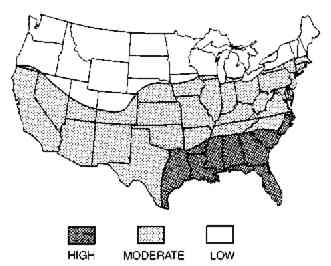 |
| Figure 1. Geographic distribution of subterranean termites. |
Distribution
Several species of subterranean termites are found in the United States; they live in every state except Alaska (Fig. 1). Two major types in Texas are the most common termite pests that seriously threaten wooden structures:
- The Reticulitermes genera of termites, found throughout the state, decreasing in frequency from the Gulf Coast to the central regions; and
- The introduced Formosan subterranean termite, generally found in the Houston Ship Channel area down to and including Galveston and Texas City, and the Beaumont-Port Arthur-Orange area. Isolated infestations have been reported in other areas of the state; termites are easily transported in timber, particularly landscaping timbers. Subterranean termites are noticed less often in the High Plains and far West Texas. Information in this bulletin applies primarily to the Reticulitermes genera of termites.
Identification
Subterranean termites are social insects that live in nests or colonies in the soil, hence their name “subterranean.” These colonies contain three forms or castes: reproductives, workers and soldiers. Individuals of each caste have several stages: the egg; the larva that develops into a pseudergate and eventually into a brachypterous nymph or soldier; and the adult. Reproductive adults have three forms: primary, secondary and tertiary reproductive (Fig. 2).
Reproductive males and females can be winged (primary) or wingless (secondary or tertiary). Each can produce new offspring. The bodies of primary reproductives, also called swarmers or alates, vary by species from coal black to pale yellow-brown. Wings may be pale or smoky gray to brown and have few distinct veins. Swarmer termites are about 1/4 to 3/8 inch long.
Secondary and tertiary reproductives in the colony are generally white to cream-colored and may have short wing buds. Developed as needed, they replace a primary queen when she is injured or dies. They also develop in addition to the primary queen and lay eggs for the colony. Supplementary reproductives, including a group of males, workers and soldiers, may become isolated from the main colony and can establish a new colony.
Termite workers make up the largest number of individuals within a colony. Workers are wingless, white to creamy white, and 1/4 to 3/8 inch long. They do all of the work of the colony -- feeding the other castes, grooming the queen, excavating the nest and making tunnels. In working, they chew and eat wood, causing the destruction that makes termites economically important.
Soldiers resemble workers in color and general appearance, except that soldiers have large, well-developed brownish heads with strong mandibles or jaws. Soldiers defend the colony against invaders, primarily ants. In some types of termites generally occurring in arid regions, soldiers are called nasutes. Nasute soldiers have pear-shaped heads with a long, tube-like projection on the front. They exude a sticky substance to entrap their enemies.
It is important to be able to distinguish between swarming termites and ants (Fig. 3). They often swarm around the same time of year, but control measures for each differ greatly.
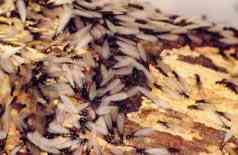 |
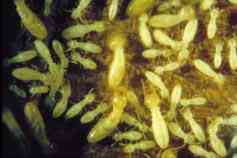 |
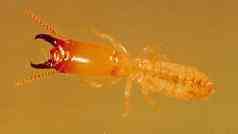 |
| Winged reproductives | Workers | Soldier |
Biology and habits
After a termite colony matures, which requires from 2 to 4 years, swarmers are produced. Swarming usually occurs from January through April, during the daylight hours, usually after a rain. Environmental factors such as heat, light and moisture trigger the emergence of swarmers. Each species has a definite set of conditions under which it swarms. The number of swarmers produced is proportionate to the age and size of the colony.
Both male and female swarmers fly from the colony and travel varying distances. They are extremely weak fliers; wind currents usually carry those that travel any distance. Only a small percentage of swarmers survive to develop colonies; the majority fall prey to birds, toads, insects and other predators. Many also die from dehydration or injury.
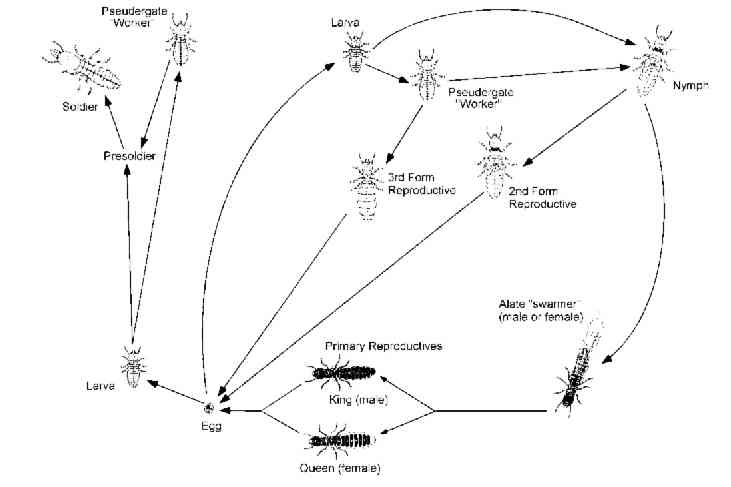 |
| Figure 2. Reticuliternestermite life cycle. |
A pair that survives lands and immediately seeks cover under rocks or other materials. The pair makes a very small nest before mating. Initially, the new queen termite lays only a few eggs. The male, or king, remains with the female because periodic mating is required for continued egg development.
Eggs are not deposited continuously; in fact, only a few hundred are deposited during the first year. In subsequent years, the young queen grows larger and lays more eggs. Larvae hatch from the eggs within several weeks and are cared for by the new king and queen. The larvae molt into pseudergate workers, and then into presoldiers or brachypterous nymphs. The colony stabilizes when the queen reaches maximum egg production. If the queen dies, secondary reproductives take over the queen’s duties.
The maximum size of a colony depends on such factors as location, food availability and environmental conditions, especially temperature and moisture. Some colonies remain small; others contain up to several thousand individuals.
New colonies form when the old colony produces swarmers or when groups of termites become isolated from the main colony and establish subcolonies. This is called colony splitting. These subcolonies may exist independently or unite with the main colony.
Subterranean termites derive their nutrition from wood and other material containing cellulose. Paper, cotton, burlap or other plant products often are actively attacked and consumed by termites. Subterranean termites cannot digest cellulose directly. They depend on large numbers of one-celled animals (protists) living in the termite hind gut to break down the cellulose to simple acetic acid, which termites can digest. Worker termites and older nymphs consume wood and share their nourishment with the developing young, other workers, soldiers and reproductives.
Termites are very attracted to odors of wood-decaying fungi that, through the decay process, make the wood easier to penetrate. In some instances, the fungi provide a source of nitrogen in the termite diet.
Moisture is important to subterranean termites, which have very little resistance to dehydration. To survive, they must maintain contact with the soil (their primary moisture source) or other above-ground moisture sources, such as in structures with defective plumbing or guttering.
Subterranean termites also must protect themselves from temperature extremes and attack by such natural enemies as ants and other insects. Termites foraging for food above ground protect themselves with shelter tubes, which are sometimes called mud tubes (Fig. 4). Worker termites build the tubes from particles of soil or wood and bits of debris held together by salivary secretions. The tubes may be thinly constructed or large and thick-walled to accommodate many termites moving vertically between the soil and the food source.
This construction material also is found lining the galleries built in wood being attacked and aids in identifying termite-damaged wood. Shelter tubes often are used to bridge masonry or other objects, allowing termites access to a food source (wood) above ground.
Damage
Dead trees and brush are the original food source of subterranean termites. When land is cleared of this material and houses are built on these sites, termites attack the structures. Termites can enter buildings through wood in direct contact with the soil, by building shelter tubes over or through foundations, or by entering directly through cracks or joints in and under foundations.
Any material in direct contact with the soil -- such as trees, vines or plumbing fixtures -- serves as an avenue of infestation. Subterranean termite swarmers may also be blown into or on structures and then start a new colony.
 |
| Figure 3. Differences between ants and termites. |
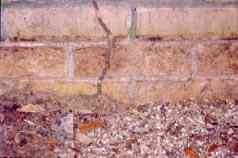 |
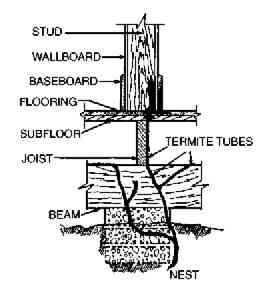 |
| Termite shelter tubes on foundation wall. | Figure 4. Typical termite shelter tubes. |
Signs of infestation
The presence of swarmers, wings or damaged wood signals that termites are infesting a structure.
Swarmers: Generally, the first sign of infestation noticed by homeowners is the presence of swarming reproductives on window sills or near indoor light. Swarmers inside the house nearly always indicate an active infestation in the structure. The presence of swarmers outdoors is a natural phenomenon, but should warn that termites are near and possibly attacking a nearby building.
Wings: Another indication is the presence of wings, discarded by swarmers as a normal part of their behavior, found near emergence sites, on window sills or in cobwebs. Infestations also can be detected by the presence of shelter tubes going up the sides of piers, utility entrances or foundation walls.
Damaged wood: Wood damage often is not found initially, but it definitely indicates termite infestation. Any wood-to-soil contact is a potential site of entry into a home. Wood that yields a dull, thudding sound when struck by a screwdriver or hammer should be examined. Careful probing of suspected areas with a sharp, pointed instrument such as an ice pick will disclose termite galleries or damage.
Characteristics of damaged wood
Subterranean termite damage almost always is confined to the soft, springwood growth of the wood. Tunnels tend to follow the wood grain. They either are lined with the same material used to build shelter tubes, or have a pale, spotted appearance resulting from soft fecal material plastered on tunnel surfaces. Look for moisture sources that may cause wood decay, which can encourage subterranean termite infestation. Extensive deterioration from wood decay can be confused with termite damage.
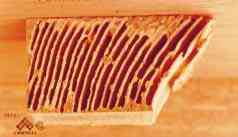 |
| Typical wood damage by subterranean termites. |
Management
Control measures include reducing the potential for subterranean termite infestation, preventing termite entry, and applying residual chemicals for remedial treatment.
Inspection
Thorough inspections can determine whether infestations and damage are present, whether remedial control measures are needed, and what conditions can encourage termite attack. Inspections can be performed by anyone who knows the basic construction elements, the environmental requirements for termite survival and the behavior of subterranean termites.
Tools and equipment needed for an inspection include a flashlight, ice pick or sharp-pointed screwdriver, ladder and protective clothing (bump cap, coverall, rubber knee pads). A clipboard, graph paper and floor plan or sketch help in recording inspection findings accurately and ensuring that the entire structure has been examined. A moisture meter can often detect increased moisture levels in the shelter tubes hidden behind walls, as well as high moisture conditions that encourage subterranean termite infestations.
Where to check outside
- Examine the foundation of the house, garage and other structures for shelter tubes coming from the soil.
- Pay particular attention to attached porches, connecting patios, sidewalks, areas near kitchens or bathrooms and narrowly confined or hard-to-see places.
- Check the soil moisture around or under the foundation to determine if faulty grade construction creates moist areas next to the structure.
- Check window and door frames and where utilities (air conditioning pipes, gas and electric services) enter the structure for termite infestation or wood decay.
- Observe roof eaves and guttering closely for defects that might cause leakage and eventual wood rot. Inspect behind closely planted, dense shrubbery or foliage.
- Note particularly any earth-to-wood contact such as fences, stair carriages or trellises.
- Open and examine any exterior electrical meter or fuse boxes set into the walls, a common point for infestation.
- Carefully inspect wood materials next to swimming pools that may be splashed frequently by water.
Where to check inside
- Probe or carefully sound exterior porches, doors and window facings, baseboards, and hardwood flooring. Be careful not to deface finished wood when probing.
- Carefully examine any attached earth-filled porches.
- Examine all known or suspected joints, cracks or expansion joints in the foundation and unusual blistering in paint or wallboard surfaces. Discoloration or staining on walls or ceilings may indicate water leaks that can decay wood and aid termite infestation. Especially inspect where plumbing or utility pipes enter the foundation or flooring.
- Check the floor covering for raised or split areas.
- Carefully examine the plumbing, particularly in bathrooms on slab construction. There should be access to the bath trap area. If none exists, build a removable plumbing hatch for periodic inspection.
- Examine the attic for shelter tubes, water leakage, wood rot or damaged wood.
- If the house is of pier and beam construction, thoroughly inspect the area between the floor and the underlying soil (crawl space) (Fig. 5). Examine the inside of the beams, chimney bases, hearths or piers for shelter tubes. Crawl-space construction should have a minimum of 18-inch clearance between floor joists and the underlying soil, and a least 12 inches between floor beams and the soil.
- Examine areas underneath or close to earth-filled porches, patios, planters and bathrooms for water leakage and termite damage. Remedial action may be required to control moisture if water stands under-neath the house.
- Look carefully at the top of the foundation wall where the floor and the wall intersect.
- Closely examine plumbing and utility lines passing through the floor of foundation walls.
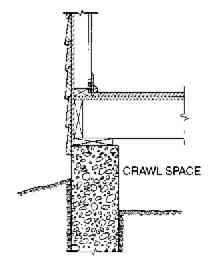 |
| Figure 5. Construction showing crawl space. |
Prevention
Many termite problems can be prevented through sound initial designs, mechanical alterations, and sanitation. The basic premise behind prevention is to deny termites access to food (wood), moisture and shelter.
Planning before construction is vital. Position or modify the building site so that the soil grade slopes away from the structure in all directions. Houses already built may need remedial grading or installation of positive drain lines. Soil-filled porches, patios, sidewalks or breezeways should slope gently away from the house.
Leave at least 2 inches of clearance between soil-filled porches and planter boxes and the house. This spacing does not prevent infestation, but allows free air movement and an opportunity for visual inspection or mechanical control. Planter boxes, if not separate from the house, should be built as an integral part so that termites cannot enter from the soil beneath. The final soil level in the planter boxes should be at least 6 to 8 inches below any wooden structure such as window frames or siding.
Eliminate all wood-to-soil contacts, including attached fence posts, stair casings, trellises and door facings (Fig. 6). Remove these structures from the soil and set them on masonry blocks or replace them with pressure-treated wood. The grade level should be at least 6 to 8 inches below the top of the foundation or wall covering. Although this clearance does not prevent construction of shelter tubes over the foundation, it does allow visual inspection. Separate shrubbery and dense foliage from the house to aid inspection of the foundation line.
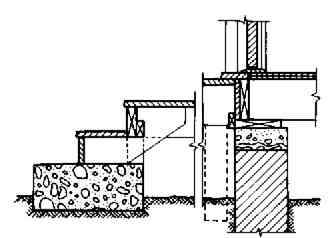 |
| Figure. 6 Removing wood-to-soil contact to prevent termite entry. |
A plastic film used to cover at least 70 percent of the area underneath the house may prevent moisture build-up in the subflooring. Place foundation wall vents opposite each other and close enough to the corners of the foundation to provide cross flow ventilation and eliminate dead air spaces. A rule of thumb for the number and size of vent openings is 1/150 of the net area covered by the building.
Wood exposed to constant wetting from rain should be pressure-treated. Wood marked “Wolmanized “ is worth the added cost. Rest wood porches, steps and stair carriages on concrete bases and separate them from the soil by at least 6 inches. Seal foundation openings, such as for plumbing wraps and service utilities, with a good grade of roofing coal tar pitch or rubberoid bituminous sealer. Remove extraneous cellulose material, such as wood scraps or stumps, from underneath and around foundations.
Chemical management
Subterranean termite attacks on houses and other above-ground wooden structures emanate from the soil. Chemicals applied to the soil can deter attacks for many years. To prevent termite entry, develop a barrier of chemically treated soil between the structure and deeper soil areas.
Chemical soil treatment before construction can be as effective as treating existing structures and is considerably less expensive. Chemicals applied during certain phases of construction eliminate the necessity of drilling injection holes, allow more accurate application and do not disrupt the household. Unfortunately, many municipalities do not require pretreatment in building codes or do not enforce compliance. When building a home, insist that the contractor or architect specify pretreatment. Check city building code requirements also.
Termiticides should be applied to the soil inside and outside foundation walls, around piers or other supports and around utility entrances (Fig. 7, 8, 9). In some instances, such as in foundations of concrete blocks or bricks, the insecticide must be pressure-injected through drill holes into foundation walls. For slab foundations, extensive drilling and pressure injection often are necessary in the foundation as well as under earth-filled porches, around fire places and along adjacent patios and sidewalks.
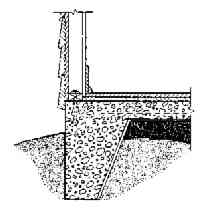 |
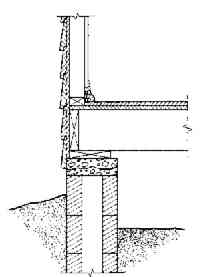 |
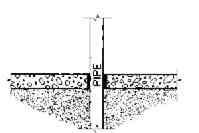 |
| Figure 7. Slab house must be completely insulated from the ground by treated soil. | Figure 8. Crawl space houses are treated only around the foundations and piers. | Figure 9. Pipes and utility lines entering through walls and slabs are heavily treated. |
Newer treatment techniques use foam or baiting systems. Foam is used to apply termiticide to various construction features of a structure, in such difficult areas as chimney bases, dirt-filled porches and sub-slab ovens where voids exist. It is unsuitable and ineffective for treating the soil directly. Make liquid applications first and then use foam as a secondary application method.
Control services offer several choices in baiting systems to treat termites. This technology requires that the applicator know termite biology and behavior to apply the baits correctly. It also demands diligent monitoring. Some baiting systems are advertised to be used alone in termite control; others are used with liquid termiticides. In general, baits require several trips to the job site for installation and monitoring. Control may take from a few weeks to more than a year.
These treatment strategies are for subterranean termites. Drywood termites are treated differently, usually by removing infested wood, using spot treatments where the colony is located, or, if needed, by tarping the structure and fumigating.
Termite treatment requires specialized equipment such as drills, pressure injectors, pressure-generating pumps and high-gallon tanks. Therefore, in almost every instance, using the services of professional pest control operators is recommended. They are familiar with construction principles and practices, have the necessary equipment, and know termite biology and habits. Members of the pest control industry who offer termite control may be licensed or certified by a state agency for competence in treatment procedures that provide safe and effective control.
The USER is always responsible for the effects of pesticide residues on livestock and crops, as well as problems that could arise from contamination of neighboring property. Always read and follow carefully the instructions on the container label.
|
| Contact Us |